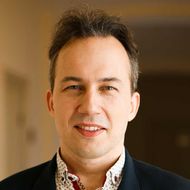Ruthenium Complexes Can Accelerate the Development of New Medicines

A group of scientists at INEOS RAS, HSE University, and MIPT have synthesised catalysts containing a ruthenium atom and an aromatic ring. The scientists have isolated the mirror forms of these catalysts and investigated their effectiveness in producing heterocycles, which are commonly found in the structures of drugs. The research findings have been published in Chemical Communications.
Isoquinoline derivatives exhibit high biological activity and are widely used as medicines such as diuretics, antibacterials, and antioxidants. One of the key stages in the synthesis of these substances is the activation of carbon-hydrogen bonds in the initial reagents. Typically, this stage must be conducted using catalysts that contain metal atoms.
Palladium compounds are most often used for such syntheses and can rightfully be considered leaders in the number of reactions they accelerate. However, they are not universally applicable. In 1993, a paper by Japanese scientists was published in Nature that described, for the first time, the carbon–hydrogen bond activation using a ruthenium catalyst. Over the last decade, the potential of these reactions has captivated scientists worldwide, with more than 300 papers published on this topic annually.
A group of Russian scientists at the A.N. Nesmeyanov Institute of Organoelement Compounds of the Russian Academy of Sciences, HSE University, and MIPT has extensive experience working with ruthenium compounds. Thus, in 2022, they obtained a ruthenium complex with an aromatic derivative of natural camphor, but it proved to be ineffective in catalysis. This year, they modified the structure of the compound to make the metal atom more accessible to reagents. A derivative of tetralin, an oil refining product, was chosen as the aromatic ring for binding ruthenium.
The resulting catalyst was separated into two enantiomers. Enantiomers are substances with the same chemical composition but different structures, similar to an object and its mirror image. The scientists used chromatography to separate the enantiomers. This process can be compared to the absorption of liquid by a sponge, where a specially selected compound acts as the sponge, absorbing the enantiomers at different rates.
'We aimed to make the synthesis as brief and straightforward as possible so that other scientists could easily use this method,' explains Dmitry Perekalin, Professor at the Joint Department of Organoelement Chemistry with the INEOS RAS, HSE Faculty of Chemistry, and Head of the Laboratory of Functional Organoelement Compounds at INEOS RAS.
The scientists used the obtained catalyst enantiomers to activate the bonds in benzamide and subsequently complete the cyclic structure of dihydroisoquinoline. The yield of the target substances was between 50% and 80%. According to the authors, the method they have developed can be used for the synthesis of other chiral catalysts, and research in this direction will continue.
The study was supported by the Russian Science Foundation, Grant 23-13-00345.
See also:
Habits Stem from Childhood: School Years Found to Shape Leisure Preferences in Adulthood
Moving to a big city does not necessarily lead to dramatic changes in daily habits. A study conducted at HSE University found that leisure preferences in adulthood are largely shaped during childhood and are influenced by where individuals spent their school years. This conclusion was drawn by Sergey Korotaev, Research Fellow at the HSE Faculty of Economic Sciences, from analysing the leisure habits of more than 5,000 Russians.
Russian Scientists Reconstruct Dynamics of Brain Neuron Model Using Neural Network
Researchers from HSE University in Nizhny Novgorod have shown that a neural network can reconstruct the dynamics of a brain neuron model using just a single set of measurements, such as recordings of its electrical activity. The developed neural network was trained to reconstruct the system's full dynamics and predict its behaviour under changing conditions. This method enables the investigation of complex biological processes, even when not all necessary measurements are available. The study has been published in Chaos, Solitons & Fractals.
Scientists Propose Novel Theory on Origin of Genetic Code
Alan Herbert, Scientific Supervisor of the HSE International Laboratory of Bioinformatics, has put forward a new explanation for one of biology's enduring mysteries—the origin of the genetic code. According to his publication in Biology Letters, the contemporary genetic code may have originated from self-organising molecular complexes known as ‘tinkers.’ The author presents this novel hypothesis based on an analysis of secondary DNA structures using the AlphaFold 3 neural network.
See, Feel, and Understand: HSE Researchers to Explore Mechanisms of Movement Perception in Autism
Scientists at the HSE Cognitive Health and Intelligence Centre have won a grant from the Russian Science Foundation (RSF) to investigate the mechanisms of visual motion perception in autism. The researchers will design an experimental paradigm to explore the relationship between visual attention and motor skills in individuals with autism spectrum disorders. This will provide insight into the neurocognitive mechanisms underlying social interaction difficulties in autism and help identify strategies for compensating for them.
Scholars Disprove Existence of ‘Crisis of Trust’ in Science
An international team of researchers, including specialists from HSE University, has conducted a large-scale survey in 68 countries on the subject of trust in science. In most countries, people continue to highly value the work of scientists and want to see them take a more active role in public life. The results have been published in Nature Human Behaviour.
Education System Reforms Led to Better University Performance, HSE Researchers Find
A study by researchers at the HSE Faculty of Economic Sciences and the Institute of Education have found that the number of academic papers published by research universities in international journals has tripled in the past eight years. Additionally, universities have developed more distinct specialisations. Thus, sectoral universities specialising in medical, pedagogical, technical, and other fields are twice as likely to admit students to target places. The study has been published in Vocation, Technology & Education.
Scientists Record GRB 221009A, the Brightest Gamma-Ray Burst in Cosmic History
A team of scientists from 17 countries, including physicists from HSE University, analysed early photometric and spectroscopic data of GRB 221009A, the brightest gamma-ray burst ever recorded. The data was obtained at the Sayan Observatory one hour and 15 minutes after the emission was registered. The researchers detected photons with an energy of 18 teraelectronvolts (TeV). Theoretically, such high-energy particles should not reach Earth, but data analysis has confirmed that they can. The results challenge the theory of gamma radiation absorption and may point to unknown physical processes. The study has been published in Astronomy & Astrophysics.
Chemists Simplify Synthesis of Drugs Involving Amide Groups
Chemists from HSE University and the Nesmeyanov Institute of Organoelement Compounds of the Russian Academy of Sciences (INEOS RAS) have developed a new method for synthesising amides, essential compounds in drug production. Using a ruthenium catalyst and carbon monoxide under precisely controlled reaction conditions, they successfully obtained the target product without by-products or complex purification steps. The method has already been tested for synthesising a key component of Vorinostat, a drug used to treat T-cell lymphoma. This approach could lower the cost of the drug by orders of magnitude. The paper has been published in the Journal of Catalysis. The study was supported by the Russian Science Foundation.
Scientists Examine Neurobiology of Pragmatic Reasoning
An international team including scientists from HSE University has investigated the brain's ability to comprehend hidden meanings in spoken messages. Using fMRI, the researchers found that unambiguous meanings activate brain regions involved in decision-making, whereas processing complex and ambiguous utterances engages regions responsible for analysing context and the speaker's intentions. The more complex the task, the greater the interaction between these regions, enabling the brain to decipher the meaning. The study has been published in NeuroImage.
Scientists Present New Solution to Imbalanced Learning Problem
Specialists at the HSE Faculty of Computer Science and Sber AI Lab have developed a geometric oversampling technique known as Simplicial SMOTE. Tests on various datasets have shown that it significantly improves classification performance. This technique is particularly valuable in scenarios where rare cases are crucial, such as fraud detection or the diagnosis of rare diseases. The study's results are available on ArXiv.org, an open-access archive, and will be presented at the International Conference on Knowledge Discovery and Data Mining (KDD) in summer 2025 in Toronto, Canada.



